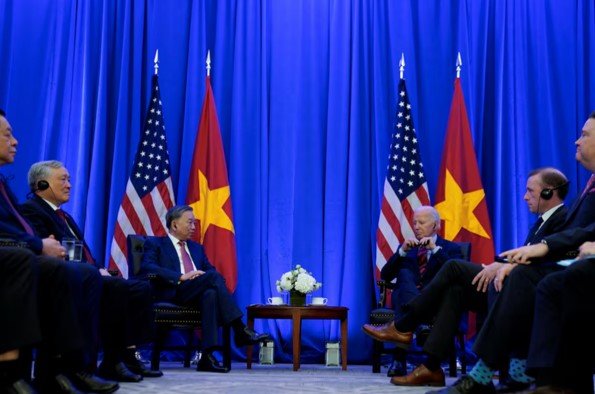Key Highlights:
- Strengthening US-Vietnam Relations: The meeting between U.S. President Joe Biden and Vietnam’s President To Lam aimed to deepen bilateral ties
- Economic Cooperation: Vietnam seeks U.S. investment, especially in technology, and lobbies for the removal of its “non-market economy” status
- Geopolitical Balancing: Vietnam is carefully balancing its relationships with the U.S., China, and Russia
- Maritime Security: Both nations emphasize freedom of navigation and the rule of law, especially in the face of regional maritime disputes in the Indo-Pacific
The recent meeting between U.S. President Joe Biden and Vietnam’s President To Lam has sparked questions about the shifting dynamics in the Indo-Pacific region. As both nations aim to deepen their relationship, this diplomatic move is seen as a potential counterbalance to Vietnam’s ties with China and Russia. With the U.S. and Vietnam investing in critical sectors like semiconductors and cybersecurity, the evolving partnership may redefine the region’s geopolitical landscape. The Indo-Pacific is a vital strategic theater, where freedom of navigation and maritime disputes, particularly with China, play crucial roles. Both countries have committed to upholding these principles, signaling that their alliance is increasingly oriented towards countering China’s influence.
Economic Cooperation: Trade, Semiconductors, and Beyond
At the heart of the U.S.-Vietnam dialogue is economic cooperation, particularly in sectors vital to global trade and technology. Vietnam, a manufacturing hub and a rising power in semiconductors, seeks to expand its economic ties with the U.S. To Lam’s discussions with American businesses, including tech giant Meta, highlight Hanoi’s ambition to attract more investment. Vietnam has also been lobbying for the U.S. to remove its “non-market economy” (NME) designation, which could lead to fewer trade restrictions and open the door for deeper economic collaboration. However, this change faces opposition from U.S. labor groups, who argue that Vietnam has not yet met the standards required to shake off the NME label.
Balancing Relations with China and Russia
Vietnam’s strategic location and its delicate balancing act between superpowers make it a focal point in Indo-Pacific geopolitics. The nation has longstanding relationships with China and Russia but is increasingly seeking to diversify its foreign partnerships to avoid over-reliance on these powers. Lam’s visit to the U.S. comes after meetings with Chinese and Russian leaders, signaling Vietnam’s intent to remain neutral but strategically cautious. The U.S., aware of Vietnam’s complex position, is pushing to strengthen ties without pushing Hanoi into a corner. By enhancing their partnership, both nations can present a united front in key areas, especially in maintaining the security of maritime routes and preventing excessive Chinese influence.
Key stats in context around US-Vietnam relations and the Indo-Pacific region:
Trade between the U.S. and Vietnam:
- In 2022, the total trade in goods between the U.S. and Vietnam reached $138 billion
- Vietnam’s exports to the U.S. were valued at around $127 billion in 2022
Vietnam’s economic growth:
- Vietnam has one of the fastest-growing economies in Southeast Asia, with a projected GDP growth rate of 6.3% in 2023
Semiconductor industry:
- Vietnam’s avails 10% of global semiconductor supply chains
Geopolitical Influence:
- U.S. and Japan being Vietnam’s major investors. U.S. investments in Vietnam reached $10 billion by 2021
Human rights:
- Vietnam is ranked 172 out of 180 countries in the 2023 World Press Freedom Index
Human Rights: A Lingering Issue in US-Vietnam Relations
Despite growing economic and security cooperation, human rights concerns remain a thorny issue in the U.S.-Vietnam relationship. U.S. officials, including representatives like Michelle Steel, continue to urge Vietnam to improve its human rights record, particularly under Lam’s leadership. The release of some activists ahead of the UN General Assembly, though symbolic, hasn’t fully addressed broader concerns. While Biden’s administration pushes for deeper ties, it is clear that these issues will continue to be a point of tension, potentially limiting how far the relationship can develop.
A Strategic Shift in the Indo-Pacific?
As the U.S. and Vietnam deepen their relationship, the geopolitical landscape in the Indo-Pacific may experience a significant shift. Strengthened economic and strategic ties between these two nations could serve as a counterweight to China’s growing influence in the region. However, the balancing act Vietnam must perform—maintaining good relations with both the U.S. and its traditional partners, China and Russia—will determine how far-reaching these changes are. The future of the Indo-Pacific will depend on whether Vietnam’s delicate diplomacy can withstand the pressures from all sides


